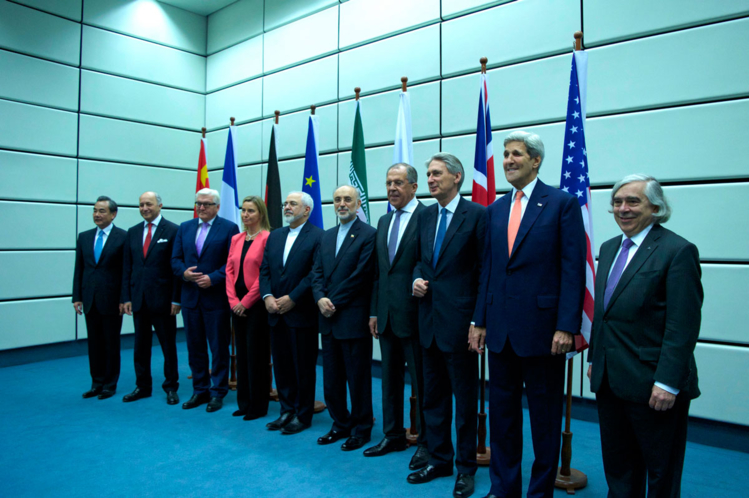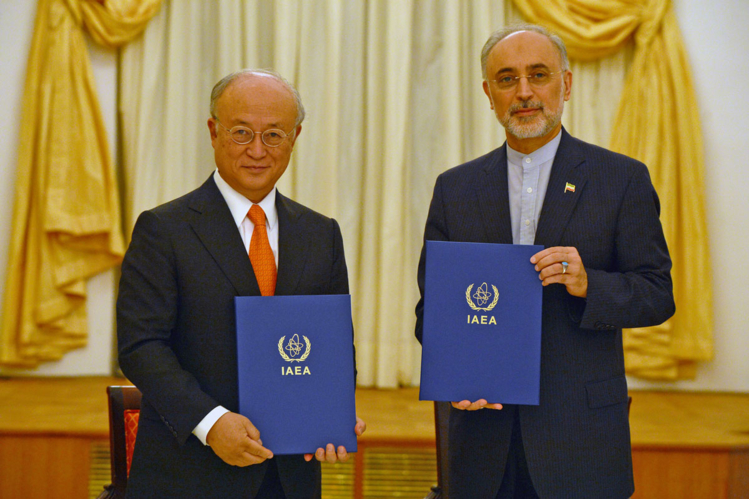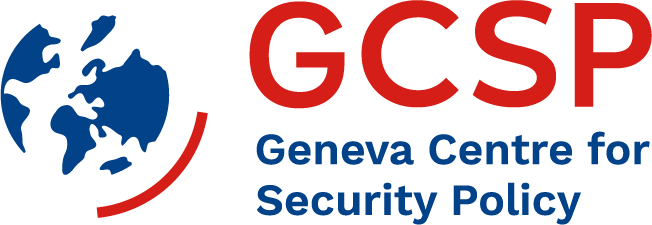THE IRAN DEAL: Achievement and Starting Point
An editorial by Marc Finaud
At the risk of contributing to the proliferation of ‘expert’ reactions to the comprehensive agreement on the Iranian nuclear programme concluded in Vienna on 14 July 2015 and hailed as “historic” by some or dubbed a “capitulation” (favourable to Iran) by others, one can more soberly describe it as both a major achievement and a potential starting point for new developments.
A Major Achievement
No one can deny that this agreement, building on previous interim or framework agreements (concluded in Geneva in November 2013 and Lausanne in April 2015), is a comprehensive one.
It results from some 20 months of intensive negotiations that put an end to a process initiated in 2003 by three European countries – France, Germany and the United Kingdom – as well as the EU High Representative for Foreign Affairs and Security Policy (EU3) and enlarged in 2006 to China, Russia and the United States (from then on, the EU3+3).
No breakthrough was achieved until two major developments occurred. One was the shift of the policy until then applied by the EU3+3, based on unilateral demands for cessation of uranium enrichment by Iran and a set of sanctions, to a policy of containment of Iran’s nuclear civilian programme and the use of the lifting of sanctions as a leverage. The second was the 2013 election of President Hassan Rouhani on a platform of removal of the sanctions to allow for economic recovery. It was thus demonstrated that a win-win agreement was easier to achieve through engagement, dialogue, active diplomacy than threats (including of military strike), pressure, isolation and unilateral demands.
Naturally, each ‘side’ had its bottom lines: for the EU3+3, it was preventing in a verifiable way any possibility for Iran to manufacture nuclear weapons; for Iran, it was preserving the technology and know-how it had acquired, presented in the form of a ‘right’ to enrich uranium as well as ensuring the total lifting of the sanctions. Looking at the result, one can only confirm that both sides have broadly fulfilled their objectives. Comparing the actual commitments by Iran with early red lines published by the Iranian President’s office, it is even clear that Tehran eventually conceded more than it had officially anticipated.1

Among the unprecedented aspects of the Vienna agreement is the whole system of verification put into place to ensure that Iran will abide by its commitments (albeit diplomatically called “voluntary measures”): the IAEA will monitor the prohibition of uranium enrichment above 3.67 per cent and the excess stockpiles above 300 kg; the number of centrifuges in excess of the 5,060 authorized ones instead of the current 20,000 (of the IR-1 first generation) will be sealed and stored under the control of the IAEA, which will keep inspecting the total number of centrifuges for 20 years and for 25 years the production of uranium concentrate (“yellow cake”); in addition to the inspections allowed by the IAEA Additional Protocol for undeclared activities or facilities and the requirement of the 3.1 Code to notify any transfer of uranium into a new facility with six months’ notice, negotiated access to suspicious military facilities will be possible. The conversion of the Arak heavy-water reactor into a research facility not producing weapons-grade plutonium will also take place under the scrutiny of the IAEA, which will thus have access to the whole Iranian fuel cycle, from mining to spent fuel (that Iran will not be able to reprocess).
The main reason why all the verification provisions are so detailed, and scrupulously described in technical annexes, is the lack of mutual trust that characterised relations between Iran and mostly western countries, under the influence of a whole history of cheating, dissimulation, reneging on past agreements or procrastination by Iran. Similarly, putting oneself in the Iranian’s shoes, one would have kept in mind the breach of past agreements concluded under the Shah by Western countries and their denial of supply of fuel or technology to Iran’s peaceful programme, without omitting the active Western support granted to Saddam Hussein in his war against Iran. To the Reagan-style “trust-but-verify” Cold War motto succeeded a new harsh “distrust-AND-verify” approach.
History was not absent from the agreement in the sense that Iran also accepted to disclose its past activities with a “possible military dimension” which had given rise to the international community’s suspicions. But the negotiators were wise enough not to make such revelations a breaking point and rather focus on the future. In the end, with the monitoring mechanism put into place that will ensure a common supervision of the implementation of the commitments (Joint Commission, ministerial meetings every two years at least), the whole agreement can be assessed as a model of cooperative security approach.
A Potential Starting Point
The endless hours spent in negotiation and dialogue, especially by the top US and Iranian negotiators, John Kerry and Mohamad Zarif, including in private conversations, presumably offered a unique opportunity to discuss issues other than percentages of enrichment and numbers of centrifuges. The mere fact that they were held in addition to the direct communications between President Obama and President Rouhani constitutes a significant change in the foreign policy of both countries. What has transpired publicly of such talks and the fairly constant rhetoric of the Iranian leadership should exclude any dramatic normalisation similar to the one between the U.S. and Cuba.
There are still too many areas of disagreement between Washington and Tehran and the history of their hostility is still too recent to allow for rapid normalisation. However, this is no reason for the U.S. not to try and bargain for a more positive influence by Iran in areas of American interest in exchange for more cooperation.
There are still too many areas of disagreement between Washington and Tehran and the history of their hostility is still too recent to allow for rapid normalisation. However, this is no reason for the U.S. not to try and bargain for a more positive influence by Iran in areas of American interest in exchange for more cooperation.
However in the short term, whether both countries have concluded secret accords or not, chances are that Iran will avoid the risk of jeopardising the Vienna agreement by too aggressive a behaviour in other areas (e.g., in support of Hezbollah or other Shiite militias in Syria, Iraq or Yemen). Already, de facto an objective alliance is emerging on the ground between on the one hand Iran, supported by Russia, and on the other hand the other enemies of the ‘Islamic State’, including the West, the Gulf States and even Israel. Saudi Arabia is certainly wary of any hegemonic attitude of its arch rival in the Middle East, and the Israeli government will maintain its opposition to the Vienna agreement because it deprives it of its main pretext for refusing a peace agreement with the Palestinians and the Arab countries. Ultimately, realignments and tacit, realist alliances against common enemies may well appear as new strategic surprises that this region is familiar with.

Another potential consequence of the implementation of the agreement with Iran, and surely one of the calculations of the Obama administration, is that, over time, thanks to the gradual lifting of sanctions and reintegration of Iran into the international community, foreign investment and international trade, attracted by the country’s potential in energy supply and a market of some 80 million consumers, will contribute to economic recovery and social dividends. It can safely be expected that the billions of dollars in unfrozen assets and potential revenues of new oil and gas exports will not be massively reinvested in military spending or support for terrorist groups but actual economic needs. Certainly as a way of placating the conservative opponents to normalisation, the rhetoric will remain critical (especially against Israel) and the vested interests of some powerful groups such as the Revolutionary Guard or the clerics will be preserved. But popular pressure for more openness, easier travel and greater freedom of expression will no doubt be exerted domestically. How the regime will respond to it will determine the future of the country.
Finally, will this agreement positively influence other nuclear proliferation crises? Of course, it is difficult to speculate or generalise. One of the reasons for Israel to worry about the Vienna agreement was demonstrated when it torpedoed the recent Non-Proliferation Treaty Review Conference that was on the verge of agreeing to a conference on a zone free of weapons of mass destruction (WMD) in the Middle East.
When it is clear that Iran will never be in a position to become a nuclear-weapon state, the pressure on the Israeli nuclear capabilities will increase and the risk of equating the Iran deal with double standards will become evident.
When it is clear that Iran will never be in a position to become a nuclear-weapon state, the pressure on the Israeli nuclear capabilities will increase and the risk of equating the Iran deal with double standards will become evident. Of course, there are other short-term priorities in the Middle East and the process of discussing a WMD-free zone will probably require more rapprochement between all the current enemies. But ultimately, the Vienna agreement could become a model for managing nuclear proliferation crises in environments characterised by mistrust and a high degree of militarisation. This cooperative approach would deserve to be attempted in South Asia and the Korean Peninsula, the two other main regions with a high potential of destabilization and conflict.
Naturally it would only help if the nuclear-weapon states also set the example in reducing further their own nuclear arsenals and the reliability of their own security on nuclear weapons, a more convincing argument to actual or potential proliferators than the current doctrine based on “do as I say, not as I do”.
[1] Jeffrey Lewis, “It’s a Damn Good Deal”, Foreign Policy, 14 July 2015.
Note: the author, Marc Finaud, is Senior Programme Advisor in GCSP's Emerging Security Challenges Programme. He expresses personal views.
Top photo: The Iran Deal is announced by EU High Representative Federica Mogherini and Iran Foreign Minister Javad Zarif at the venue of the nuclear talks in Vienna, Austria on July 14, 2015. © European External Action Service
Disclaimer: The views, information and opinions expressed in the written publications are the authors’ own and do not necessarily reflect those shared by the Geneva Centre for Security Policy or its employees. The GCSP is not responsible for and may not always verify the accuracy of the information contained in the written publications submitted by a writer.
Marc Finaud is a former French diplomat who was seconded to the GCSP from 2004 to 2013 and is now a staff member. At the GCSP, Mr Finaud was leading activities related to Arms Proliferation.
